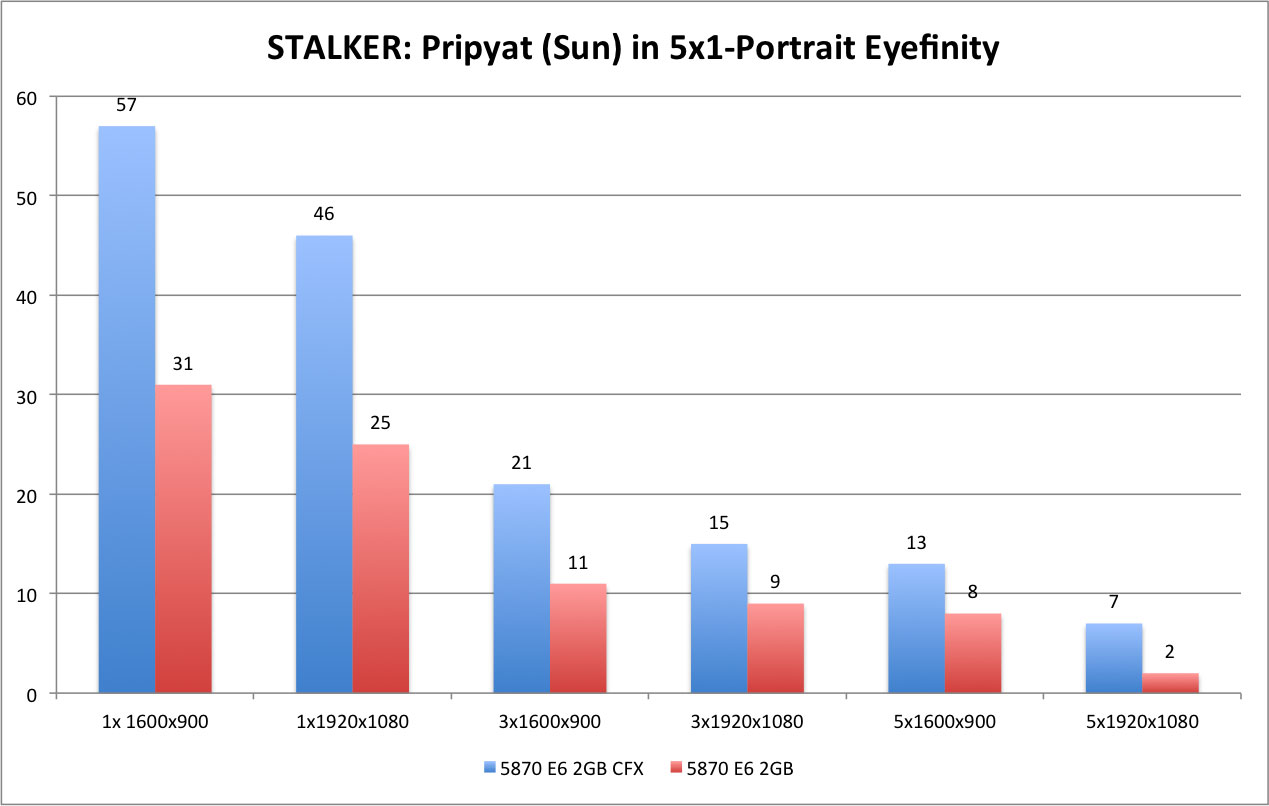AMD Eyefinity 5x1-Portrait Review - Benchmarking
System Specs
These benchmarks were done using the 10.12 Preview benchmark, which introduced support for 5x1-Portrait mode.
- Windows 7
- EVGA X58 Tri-SLI Motherboard
- Intel i7 920 at 4x2.67GHz
- 12GB G.Skill DDR3 RAM
- 2x Samsung 320GB T-Series HDD (one for the OS and games; one for swap file and FRAPS)
- LG Super Multi Blu (HD-DVD/Blu-Ray Player)
- Onboard audio
- Corsair HX1000
- My Open PC Doma Pro PCI Case
- Logitch K340 Keyboard & Performance MX Mouse
- Ergotech Heavy Duty Triple Desk Stand
- 5x Dell U2211H IPS 16:9 1920x1080 Displays
My test rig remains unchanged, except for a new case. For easier testing, I recently migrated to the Doma Pro PCI test bench from My Open PC (review on that coming soon).
Games Tested
I have added a number of new titles to my benchmark suite recently. I have added Aliens vs. Predator, F1 Racing, Heaven v2, and Mafia 2. In addition, I have added Half-Life 2: Lost Coast to this specific benchmark article. In general, HL2 blows through every card we test, and hits CPU limits at 200+ fps. I thought it good to bring HL2:LC back into the mix for the first 5x1-P benchmark.
- AvP
- Battle Forge
- DiRT 2
- F1
- Far Cry 2
- HAWX
- Heaven v2
- Half-Life 2: Lost Coast
- Just Cause 2
- Mafia II
- S.T.A.L.K.E.R. - Call of Pripyat Benchmark Tool
As always, all games are tested at max settings (unless otherwise noted), with 4xAA and 16xAF enabled.
AMD Eyefinity 5x1-Portrait Review - Aliens vs. Predator
Aliens vs. Predator (AvP) is an FPS title from Rebellion Studios. It allows players to take on the role of either an Alien, a Predator or a human space marine. While the title received mixed reviews, it is a DX11 graphics powerhouse that can bring many machines to their knees. The demo follows a number of Alien creatures, and makes extensive use of shaders and tessellation. Hitting 60fps on a Core i7-920 requires a pair of ATI Radeon HD 5870 E6's in CrossFire.
3x1 Eyefinity configurations cut fps by about 2.5x from the single panel performance. While moving to a five panel setup ads 66% more pixels, performance is only reduced by about 33%.
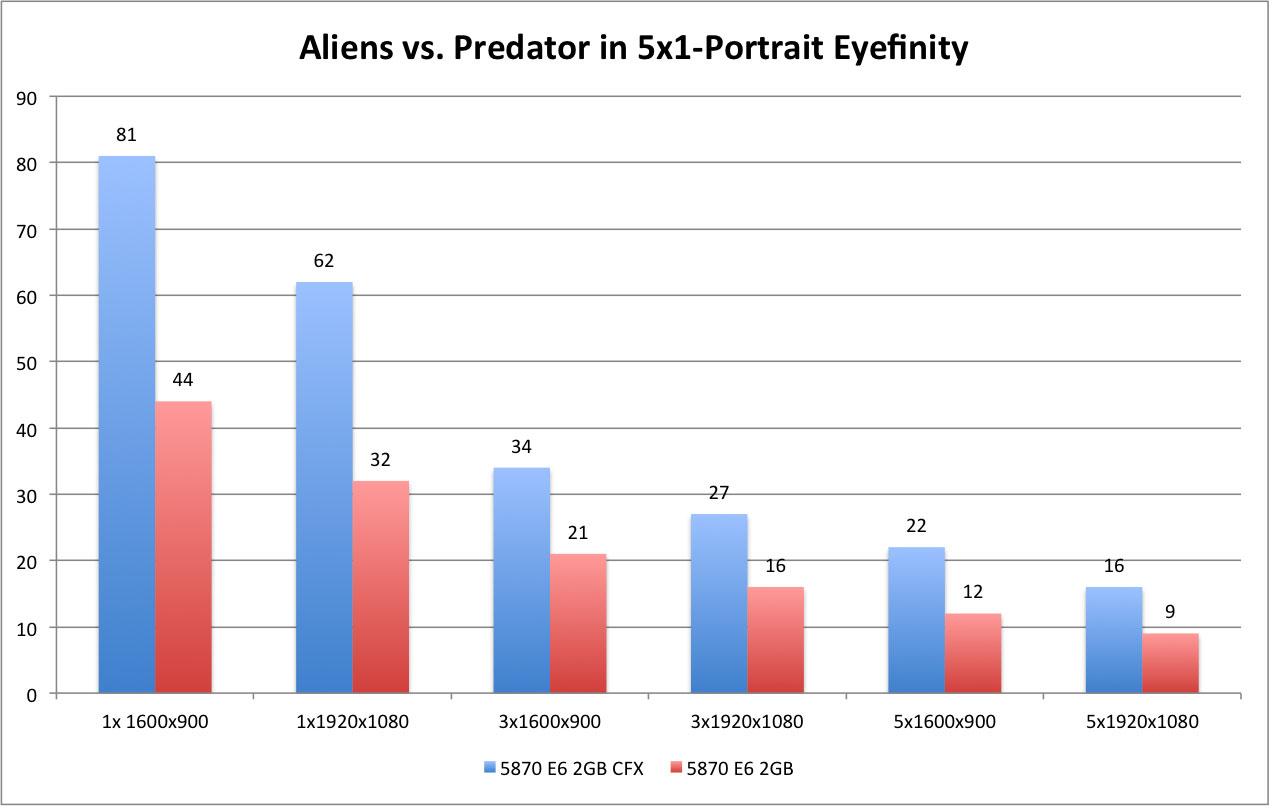
AMD Eyefinity 5x1-Portrait Review - Battle Forge
Battle Forge is the free-to-play RTS from Electronic Arts. It offers a steampunk/fantasy RTS experience, where armies are build based on "decks" of cards similar to the Magic: The Gathering card game.
Battle Forge is one of AMD's spotlight (my terminology) games, as it offers both DX11 and proper Eyefinity support. The game offers a number of DX11 features, and a wealth of options for tuning performance. Specifically, Battle Forge uses DX11 and Shader Model 5.0 to compute HighDefinition Ambient Occlusion (HDAO). For our tests we maxed out all of the settings and forced DX11 through the config.xml file.
The Radeon 5870 approaches 60fps in a single widescreen, at max settings. A single card will get close to 30fps in 3x1-L Eyefinity, and push past with a pair. A pair of cards also average 30fps in 5x1-P.
As seen with AvP, the decrease in fps is less (as a percent) than the increase in pixels when moving from 3x1 to 5x1.
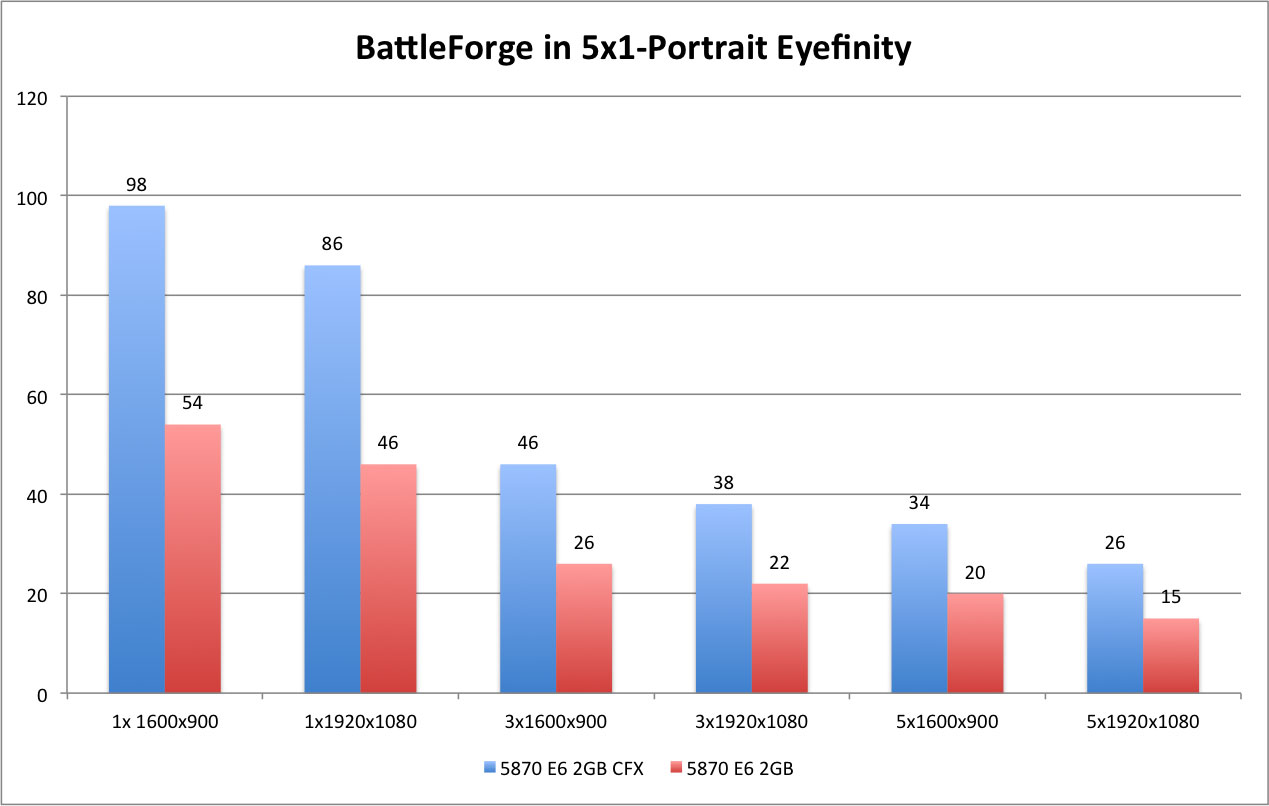
AMD Eyefinity 5x1-Portrait Review - DiRT 2
Dirt 2 is the latest iteration of the Dirt rally racing series from Codemasters. Like Battle Forge, Dirt 2 is a spotlight game for AMD. Like Battle Forge it offers proper Hor+ gameplay in Eyefinity and DX11 support. Unless the user goes into the "hardware_settings_config.xml" file and forces DX9, Dirt 2 runs in DX11 mode. Unfortunately Dirt 2 does not offer a DX10 mode. This is unfortunate, as many games show improved performance when running in DX10 vs. DX9.
The true (noticeable) DX11 features come in to play based on the user settings in the in-game graphics options. Several key features are the "Hardware Tessellated Dynamic Water" (achieved through "Ultra" quality water), "Hardware Tessellated Dynamic Cloth" (achieved through "High" quality cloth), and DX11 Accelerated HDAO (through "High" quality HDAO).
The DX11 water and cloth offer more realistic geometry and movement. The DX11 water produces actual waves in deep puddles (as the player drives through), rather than simple "swirls" in the texture surface. The DX11 cloth offers more realistic ripples and waves in the cloth material over the DX9 version. On the other hand, the DX11 HD Ambient Occlusion (HDAO) offers an accelerated computation path.
DX11 doesn't necessarily provide earth-shaking changes to gameplay. But, it provides more realistic "movement" in the world's objects - cloth, water, grass, etc. While a DX9 or DX10 game is perfectly enjoyable, the DX11 technology offers better immersion by making the "little things" more lifelike. Additionally, it offers better computation paths through increased parallelism (and better computation paths for DX10), much like DX10 offered better performance (over DX9) in games such as Far Cry 2.
A single Eyefinity6 card will average 30fps in 5x1-P. A CFX setup will not hit 60fps at max settings, though settings can easily be adjusted to hit 60fps+.
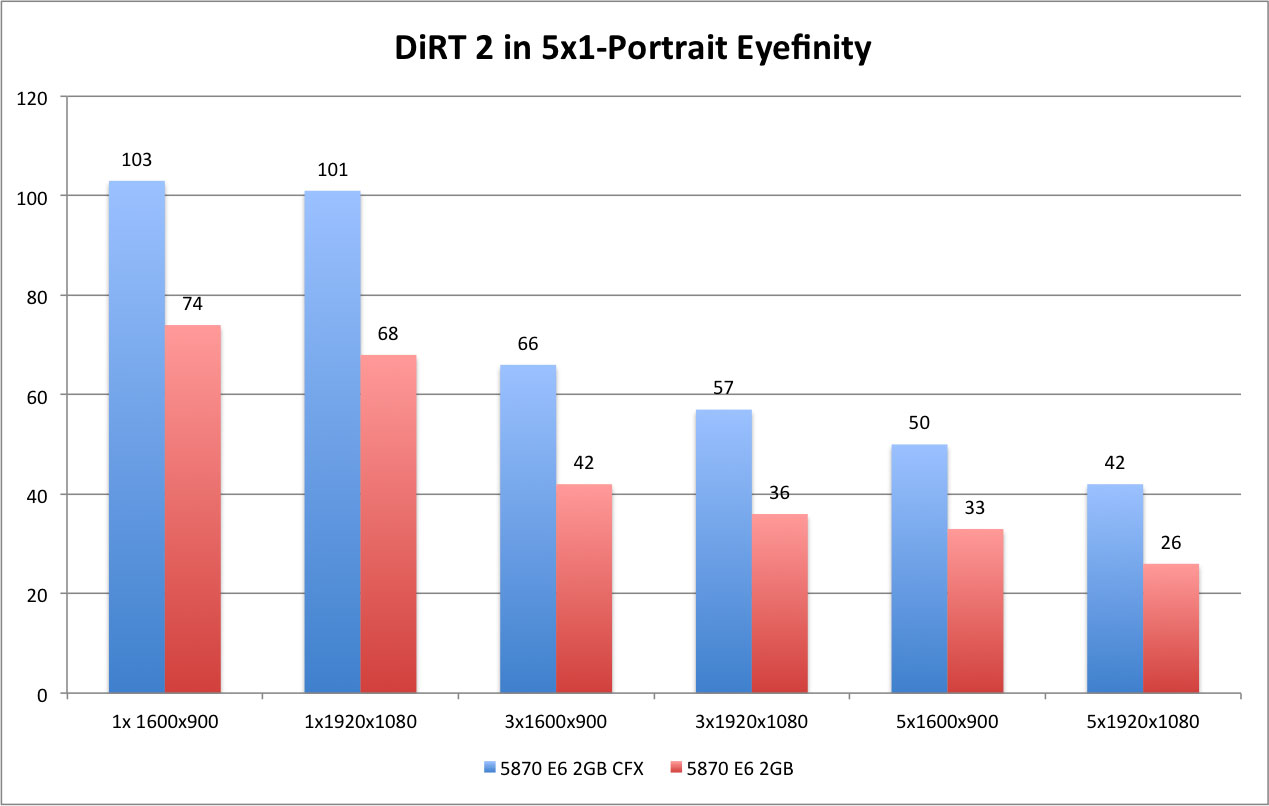
AMD Eyefinity 5x1-Portrait Review - F1 (2010)
F1 (Formula 1) is a new racing title from Codemasters. Like their previous title (DiRT 2), F1 makes extensive usage of DX11 technology with cloth, fluid dynamics and tessellation. The title is much more strenuous on a single widescreen, compared to DiRT 2. The title hits a ~45fps cap with in 3x1-L and 5x1-P using 1600x900 panels.
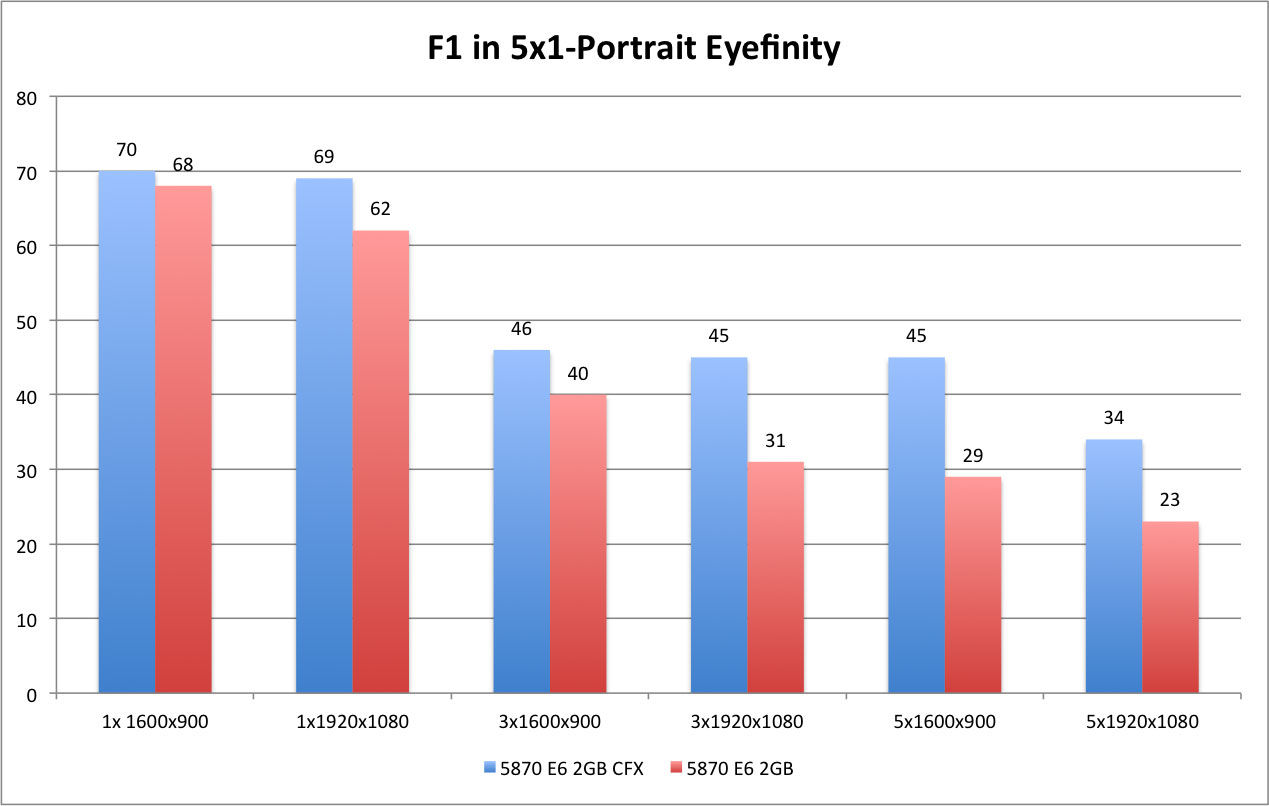
AMD Eyefinity 5x1-Portrait Review - Far Cry 2
Far Cry 2 (and the whole Cry/Crysis series) has long been considered a system killer. If not a killer, then at least a good strong test. As always, we run our test at max settings with 4xAA. The benchmark tool within Far Cry 2 offers settings for High, Very High and Ultra. We chose Ultra with 4xAA.
While once a true system killer, Far Cry 2 shows that hardware catches up to software. At max settings, CFX cards will hit 60fps in both 3x1-L and 5x1-P (except for 5x1080p panels). Making a few adjustments at full five panel resolution will allow the user to hit 60fps+.
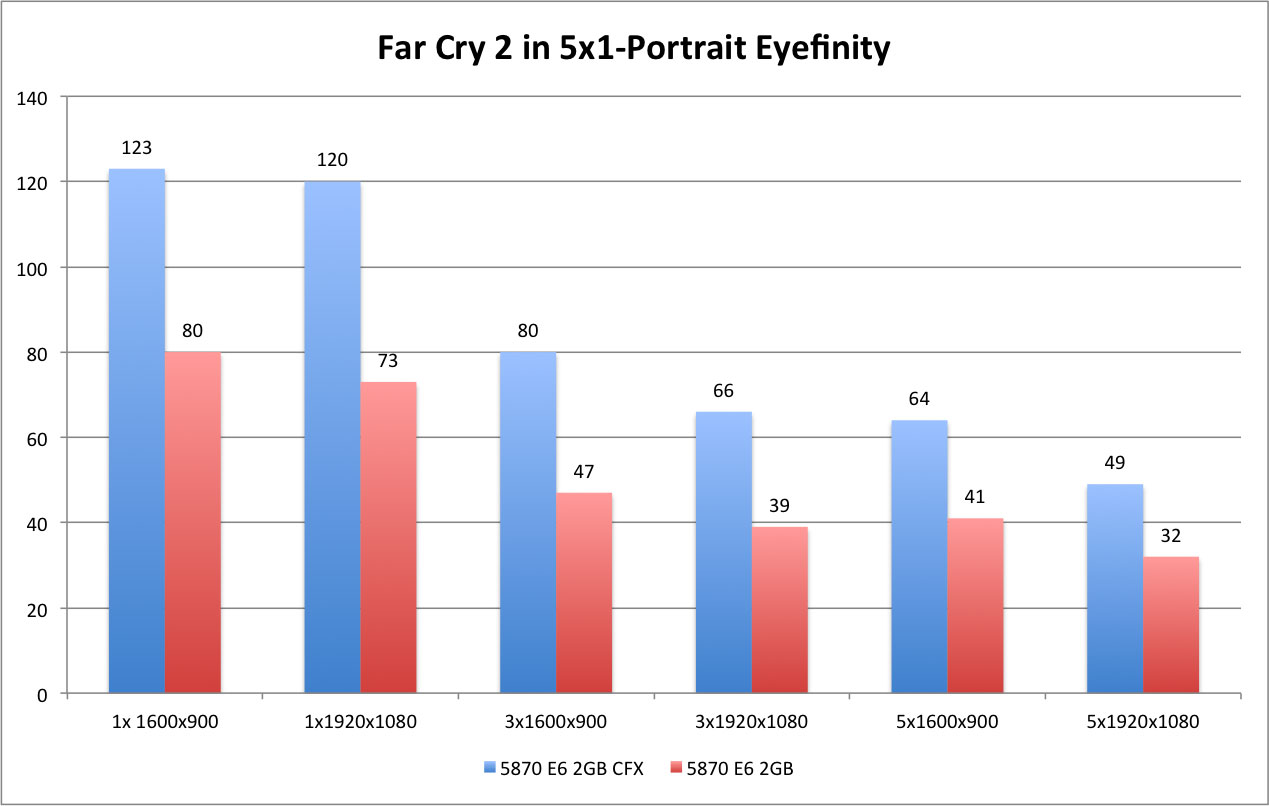
AMD Eyefinity 5x1-Portrait Review - H.A.W.X.
H.A.W.X. is one last title that AMD has been showing off since the Radeon 5000 line launched. While the other titles are Hor+ and offer cutting-edge DX11 features, HAWX is quite the opposite. While it is a Hor+ title, it is only a DX10 title and runs quite well on a wide variety of hardware.
The well running and scalable title makes it a natural fit when showcasing both lower-end hardware pushing three panels, and high-end hardware pushing six panels. It also comes as no surprise that the additional VRAM largely goes unused, considering the title runs capably on lower hardware.
One note in the HAWX benchmark. Above 1920x1080 the game simply would not allow 4xAA. While the scores provide that the title could handle it, the option simply is not available. Though it isn't our norm, we chose to accept 2xAA so that we could get consistent readings across the spectrum of hardware.
While a single panel (or really even a 3x1 setup) are no match for a single E6 card, at max settings. A CFX set averages 60fps in a 5x1 setup.
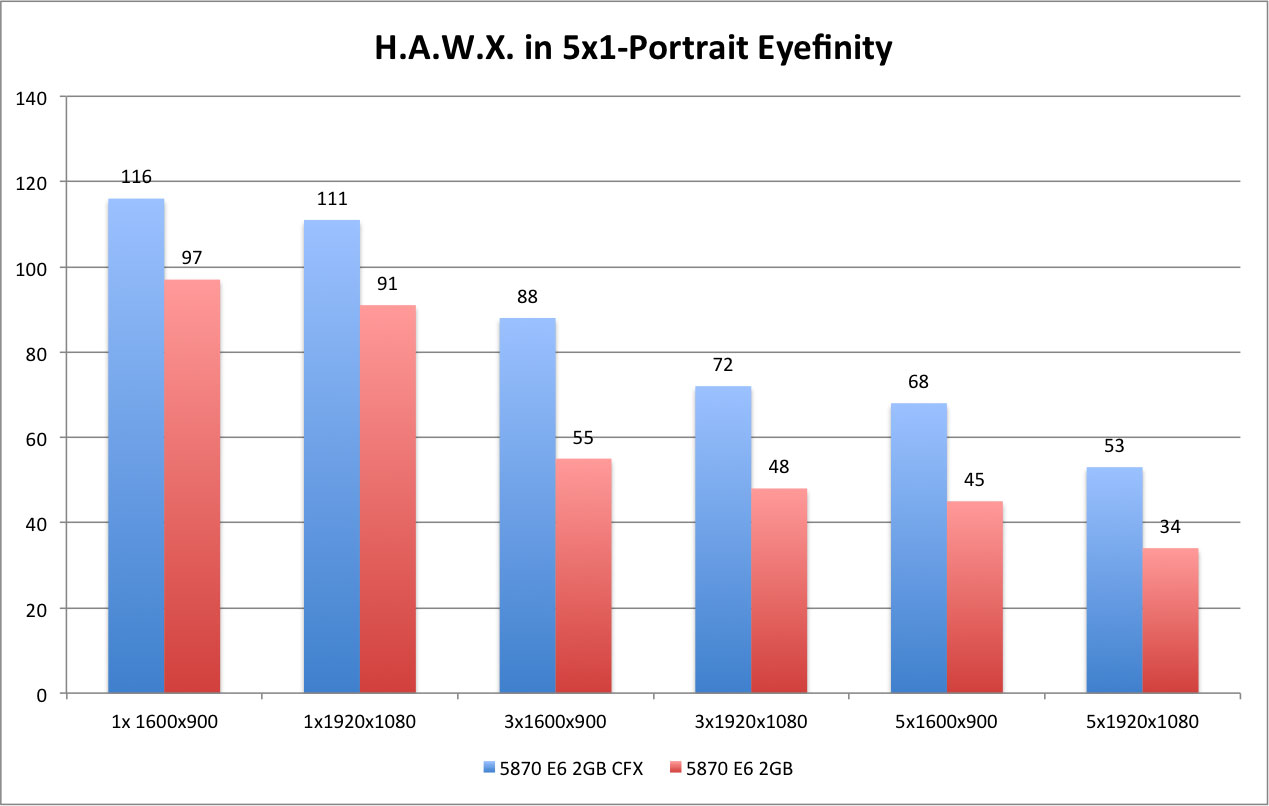
AMD Eyefinity 5x1-Portrait Review - Half-Life 2: Lost Coast
Half-Life 2 is the classic first person shooter. It is a DX9 title. At this point DX9 doesn't really tax graphics hardware with any of its "features," and any benchmarking comes down to a pushing raw pixels. Half-Life 2 does not like the extra video RAM provided by the Eyefinity6, and until you get to Eyefinity and beyond it doesn't like CrossFireX.
A single E6 card blasts pat 60fps in 5x1-P, and doubles it in 5x1600x900. While Half-Life 2 isn't considered close to demanding, this should bode well for Left4Dead 2 and Team Fortress 2 players.

AMD Eyefinity 5x1-Portrait Review - Heaven v2
The Unigine Heaven Demo is unique in that it is the only demo which allows for the following components in one package.
- Synthetic Demo (i.e., a demo designed to "test" a system)
- Comparable tests of DX9, DX10 and DX11
- Is Hor+ (rather than limited to a few predefined aspect ratios)
The ability to compare DX9, DX10 and DX11 in the same environment allows for the unique ability to see how the different cards perform across these different comparable environments. Tessellation was set at Normal Mode.
The updated 2nd version of the Heaven demo offers more segments and more options. A 2GB card is required for the multi-monitor setups, and 5x1-P offers surprisingly close performance to 3x1-L.
AMD Eyefinity 5x1-Portrait Review - Heaven v2 (DX9)
The Unigine Heaven Demo is unique in that it is the only demo which allows for the following components in one package.
- Synthetic Demo (i.e., a demo designed to "test" a system)
- Comparable tests of DX9, DX10 and DX11
- Is Hor+ (rather than limited to a few predefined aspect ratios)
The ability to compare DX9, DX10 and DX11 in the same environment allows for the unique ability to see how the different cards perform across these different comparable environments. Tessellation was set at Normal Mode.
The updated 2nd version of the Heaven demo offers more segments and more options. A 2GB card is required for the multi-monitor setups, and 5x1-P offers surprisingly close performance to 3x1-L.

AMD Eyefinity 5x1-Portrait Review - Heaven v2 (DX10)
The Unigine Heaven Demo is unique in that it is the only demo which allows for the following components in one package.
- Synthetic Demo (i.e., a demo designed to "test" a system)
- Comparable tests of DX9, DX10 and DX11
- Is Hor+ (rather than limited to a few predefined aspect ratios)
The ability to compare DX9, DX10 and DX11 in the same environment allows for the unique ability to see how the different cards perform across these different comparable environments. Tessellation was set at Normal Mode.
The updated 2nd version of the Heaven demo offers more segments and more options. A 2GB card is required for the multi-monitor setups, and 5x1-P offers surprisingly close performance to 3x1-L.

AMD Eyefinity 5x1-Portrait Review - Heaven v2 (DX11)
The Unigine Heaven Demo is unique in that it is the only demo which allows for the following components in one package.
- Synthetic Demo (i.e., a demo designed to "test" a system)
- Comparable tests of DX9, DX10 and DX11
- Is Hor+ (rather than limited to a few predefined aspect ratios)
The ability to compare DX9, DX10 and DX11 in the same environment allows for the unique ability to see how the different cards perform across these different comparable environments. Tessellation was set at Normal Mode.
The updated 2nd version of the Heaven demo offers more segments and more options. A 2GB card is required for the multi-monitor setups, and 5x1-P offers surprisingly close performance to 3x1-L.

AMD Eyefinity 5x1-Portrait Review - Just Cause 2
Just Cause 2 is the wildly popular sequal to the wildly popular Just Cause. You take control of protagonist Rico Rodriquez and rain down over the top destruction across a small desert island. The game is a free roaming title that offers literally limitless options to wreck havoc with your "hook shot" grapling device.
While the benchmark tool doesn't offer anything in the way of explosions or destruction, it does offer some beautiful scenery that is still quite demanding on multi-monitor environments.
The CFX configurations do hit 60fps at 3x1600x900, and cross 30fps for all higher resolutions. A single card will do 30fps in all but the highest resolution.
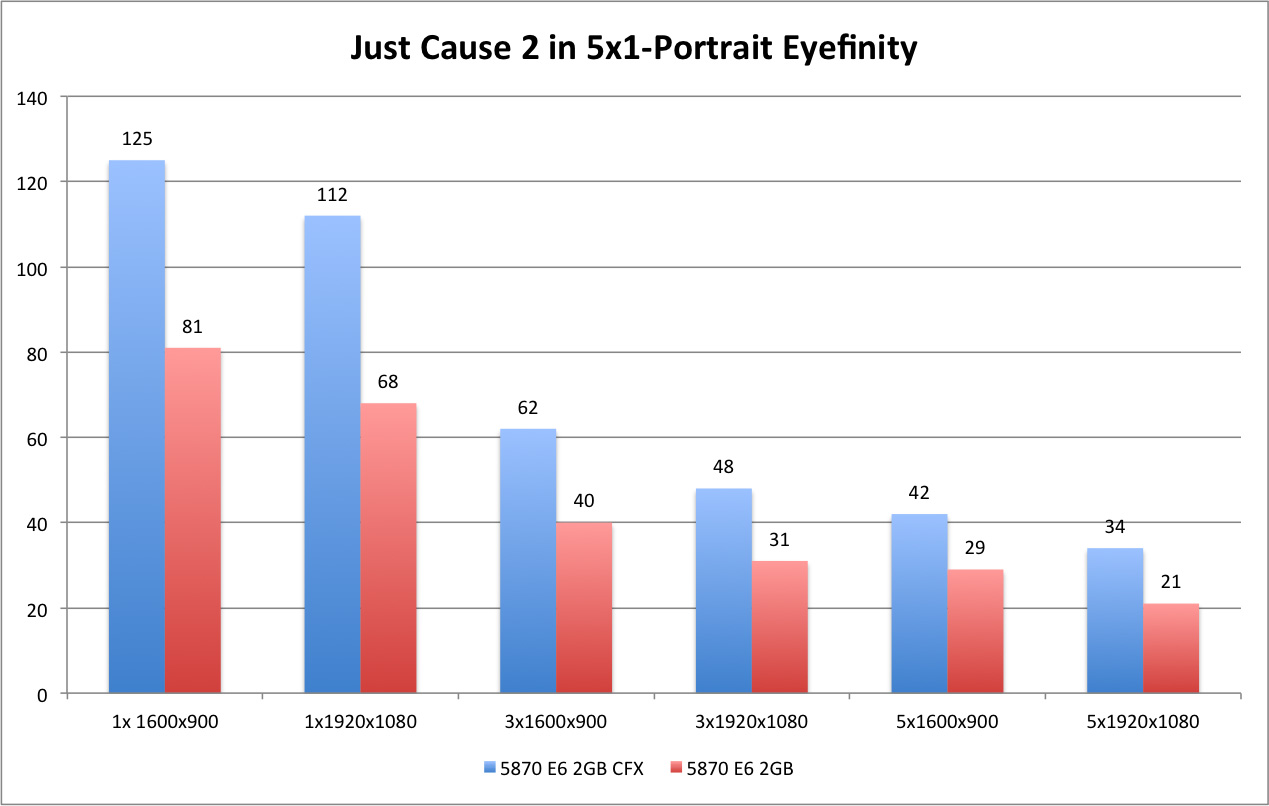
AMD Eyefinity 5x1-Portrait Review - Mafia II
Mafia II is an open world "crime" title from 2K Games. It is the second game in the Mafia series. The demo comes with a built-in benchmark tool that offers both indoor and outdoor environments, various lighting effects and fire.
A single card won't quite hit 30fps in Eyefinity, but a CFX setup will in 3x1-L and just barely miss it at 5x1600x900. Mafia II proves to be quite a demanding benchmark for Eyefinity.

AMD Eyefinity 5x1-Portrait Review - S.T.A.L.K.E.R.: Call of Pripyat
Prior to the game's release, the developer put out a benchmarking tool to test your system configuration. It offers a number of different options for utilizing DX9, 10 or 11 code paths. It also offers options for varying levels of HDAO and Shadow Quality. The demo itself isn't very pretty to look at (lots of dirt and dirt-colors), but it does put a beating on your system.
Like the Heaven demo, the demo basically will not run at 5760x1080 using 4xAA, with only 1GB of VRAM. The 2GB card Eyefinity6 card does run the demo, though it proves to be quite demanding. 5x1600x900 performs on par with either 3x1-L setup, though 5x1920x1080 brings the CFX setup to its knees.
AMD Eyefinity 5x1-Portrait Review - S.T.A.L.K.E.R.: Call of Pripyat (Daylight)
Prior to the game's release, the developer put out a benchmarking tool to test your system configuration. It offers a number of different options for utilizing DX9, 10 or 11 code paths. It also offers options for varying levels of HDAO and Shadow Quality. The demo itself isn't very pretty to look at (lots of dirt and dirt-colors), but it does put a beating on your system.
Like the Heaven demo, the demo basically will not run at 5760x1080 using 4xAA, with only 1GB of VRAM. The 2GB card Eyefinity6 card does run the demo, though it proves to be quite demanding. 5x1600x900 performs on par with either 3x1-L setup, though 5x1920x1080 brings the CFX setup to its knees.

AMD Eyefinity 5x1-Portrait Review - S.T.A.L.K.E.R.: Call of Pripyat (Night)
Prior to the game's release, the developer put out a benchmarking tool to test your system configuration. It offers a number of different options for utilizing DX9, 10 or 11 code paths. It also offers options for varying levels of HDAO and Shadow Quality. The demo itself isn't very pretty to look at (lots of dirt and dirt-colors), but it does put a beating on your system.
Like the Heaven demo, the demo basically will not run at 5760x1080 using 4xAA, with only 1GB of VRAM. The 2GB card Eyefinity6 card does run the demo, though it proves to be quite demanding. 5x1600x900 performs on par with either 3x1-L setup, though 5x1920x1080 brings the CFX setup to its knees.
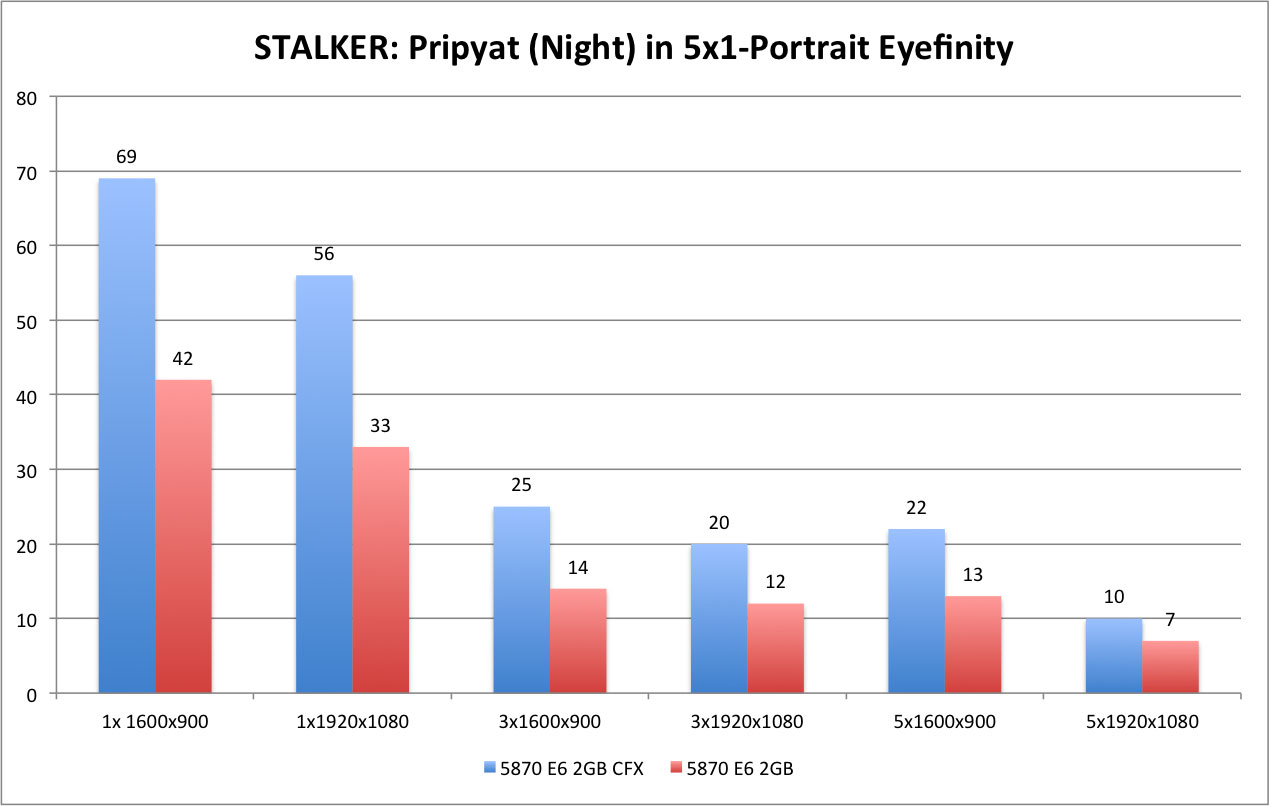
AMD Eyefinity 5x1-Portrait Review - S.T.A.L.K.E.R.: Call of Pripyat (Rain)
Prior to the game's release, the developer put out a benchmarking tool to test your system configuration. It offers a number of different options for utilizing DX9, 10 or 11 code paths. It also offers options for varying levels of HDAO and Shadow Quality. The demo itself isn't very pretty to look at (lots of dirt and dirt-colors), but it does put a beating on your system.
Like the Heaven demo, the demo basically will not run at 5760x1080 using 4xAA, with only 1GB of VRAM. The 2GB card Eyefinity6 card does run the demo, though it proves to be quite demanding. 5x1600x900 performs on par with either 3x1-L setup, though 5x1920x1080 brings the CFX setup to its knees.
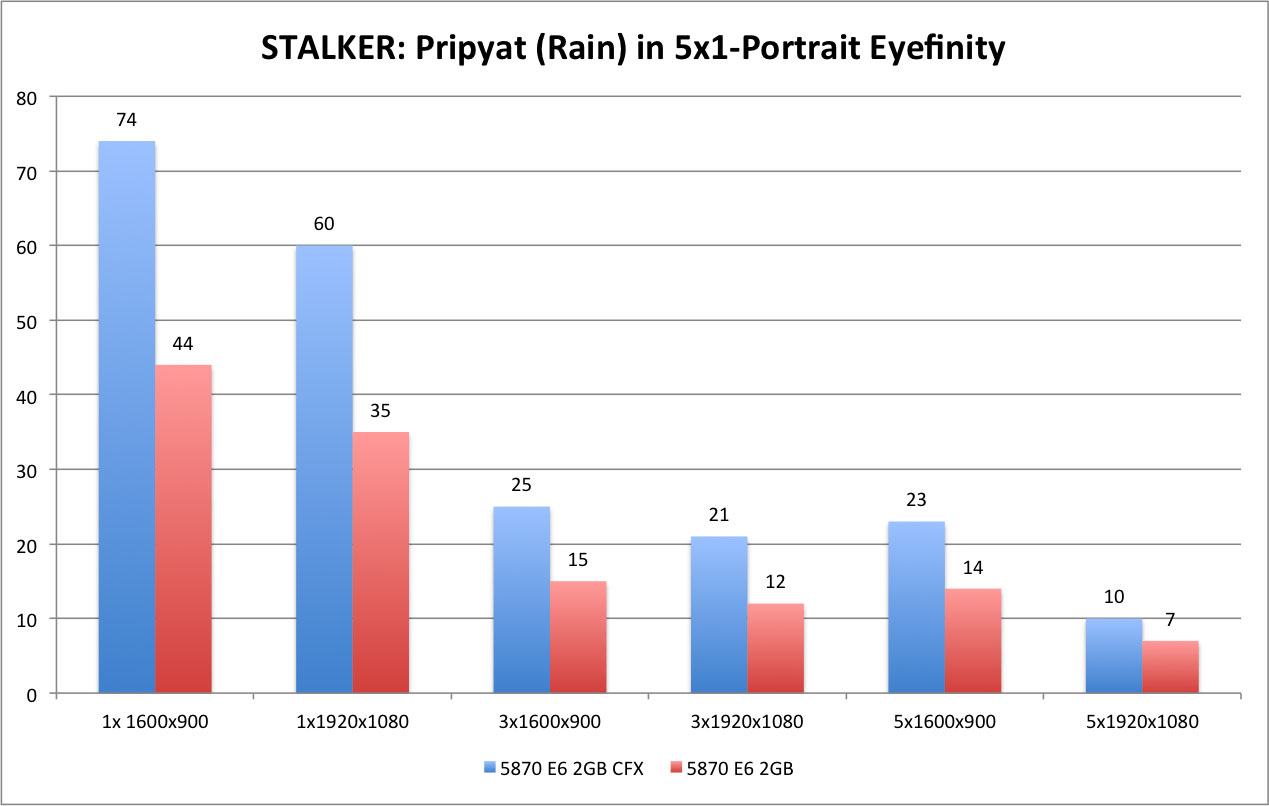
AMD Eyefinity 5x1-Portrait Review - S.T.A.L.K.E.R.: Call of Pripyat (Sun Shafts)
Prior to the game's release, the developer put out a benchmarking tool to test your system configuration. It offers a number of different options for utilizing DX9, 10 or 11 code paths. It also offers options for varying levels of HDAO and Shadow Quality. The demo itself isn't very pretty to look at (lots of dirt and dirt-colors), but it does put a beating on your system.
Like the Heaven demo, the demo basically will not run at 5760x1080 using 4xAA, with only 1GB of VRAM. The 2GB card Eyefinity6 card does run the demo, though it proves to be quite demanding. 5x1600x900 performs on par with either 3x1-L setup, though 5x1920x1080 brings the CFX setup to its knees.
